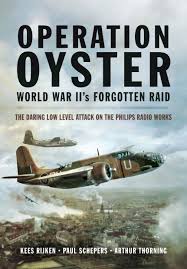| Title: | Operation Oyster |
| Authors: | Kees Rijken, Paul Schepers, Arthur Thorning |
| Publisher: | Pen & Sword Books |
| Released: | 2014 |
| ISBN: | 9781473821095 |
| Pages: | 227 |
| Review: |
Operation Oyster was carried out on the 6th December 1942 by No.2 Group of RAF Bomber Command. It was an air attack on the Philips Radio Works in Eindhoven, in the Netherlands. It was a daring low-level attack which turned out to be a notable success for the allies as it cost the Germans an estimated six months loss of production. However, you won’t find too many books about the raid, nor did the airmen receive as much recognition as, for instance, the Dambusters did. But now Kees Rijken, Paul Schepers and Arthur Thorning have published a book about this raid which, they hope, gives the airmen who took part in the attack the attention they deserve. Kees Rijken was a school boy who lived in Eindhoven during the Second World War. Ever since he was a kid he has had a great interest in aeroplanes. During the war he regularly spotted German and allied aircraft from the roof of his parents’ house. He was there on 6 December 1942 as well and was an eyewitness of Operation Oyster. Many years later he conducted an extensive research after the raid together with his son-in-law Paul Schepers. The British Arthur Thorning researched the raid as well and during one of his visits to the RAF Museum at Hendon he discovered research documents from the Dutchmen. The three researchers agreed to work together to write this book, which they regard as a tribute to all involved, both in Britain and in The Netherlands. The book contains ten chapters. The first chapter covers the history of the Philips Radio Works. From there on the authors describe why the factory was chosen as a target, which forces were available for the attack and how they were prepared for this daring low-level attack. The raid itself is described in the fifth chapter. The last chapters cover the aftermath. The whole story contains a lot of illustrations; photos of the airmen, the aircraft, the raid itself and pictures of the Philips Radio Works taken after the raid. Some of the captions are very detailed and even mention from which aircraft the photo was taken. The maps are also very useful to get an idea of the routes flown and the area of the complex. What might surprise people when they look at the contents is that half of the book is appendices. However, these are very interesting. They include for instance the original No.2 Group Operation Order 82 which is a very useful addition to the story of Operation Oyster. The appendices also contain a Philips Fire Service Report and death rolls with the names of all the RAF, German and civilian casualties. The list of civilians is very detailed with name, date of birth, address and family information mentioned. The RAF casualties are sorted by crew and for both the allied airmen as well as the German soldiers there are photos of their headstones. The operation is extremely well researched which makes the story very interesting to read. Apart from that, the book also shows how fertile a cooperation between local people and British researchers can be. A good example is the railway line which was used as guide by the allied airmen. Most researchers wouldn’t have had the knowledge to identify the exact location as the railway has long since been removed. But Kees Rijken grew up in the area during the war so he was able to analyse the films made by the bombers and identify the exact route. It is another reason why the extensive research of the three men has resulted in a very good book. Therefore this book is recommended to everyone interested in the air war. |
| Rating: |
|
Information
- Article by:
- Pieter Schlebaum
- Published on:
- 13-11-2014
- Feedback?
- Send it!




